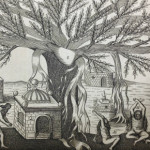
What Are We Actually Doing in Asana? (introducing the WAWADIA project)
January 6, 2014
“I am not (what you need from) my body”: expanding on a yoga meme
February 5, 2014I just completed the first week of interviewing for “What Are We Actually Doing in Asana?” As I expected, and resonant with my own experience with asana, I heard stories of re-embodiment and renewed courage. Many experienced relief from chronic pain, both physical and emotional. Many felt that physical yoga practice was integral to the most significant period of personal change in their lives. Some people came to asana as though they were coming home.
Also resonant with my experience and expectation, I heard stories of crippling injuries, poor self-regard leading to the failure to establish boundaries, and of course incompetent teaching ranging from the negligent to the invasive to the abusive. As I discussed some of these tragic and infuriating examples with a long-term, highly-esteemed teacher, she asked me: “Can we start to use the ‘cult’ here?”
Between these extremes, the subtler ideas and feelings that are the target of this study (so far as I imagine it) began to emerge. Alongside stories of positive growth, subjects told me about asana-related injuries they kept secret, blamed themselves for, and obsessed over as symbols of a kind of original sin. Subjects told me of how they either internalized the aggressive attitudes of instructors more interested in the presumed rules of practice than its effects, or how they used yoga to reify their pre-existing attitudes of bodily ambivalence.
Reports of very narrow views on injury and recovery emerged, painting a picture of an often insular and exclusive physical culture protecting itself from outside scrutiny. I heard stories of teachers who attributed physical injuries to metaphysical forces. I heard of people trying to understand their sensations — often under the influence of a teacher — as “good pain”. I heard stories of practitioners not pursuing medical treatment for injuries – sometimes for years – because they didn’t quite consider their practice to be a material phenomenon that biomedicine or other forms of athletic knowledge could understand. They were obviously doing something deeper than sport, but it was also older and larger than medicine. They narrativized pain in such a way that it could not be spoken to or about in terms they considered mundane or conventional. While the subjectivity of pain makes it impossible to assess how extraordinary anyone’s pain actually is, I noticed that for many of these practitioners, pain needed to be felt and sometimes expressed as extraordinary.
One of the most resonant correlations between pain, acute injury, chronic injury and asana has been the bias towards “openness”, “softness”, and all of the other values associated with the stretching aspects of practice. The list of compression injuries is long and devastating – stenosis, labral tears, cervical subluxations – but by and large most injuries involve a breakdown of tensile strength from lengthening actions that are virtually dismembering in intensity. Hamstring tears, gluteal tears, piriformis syndrome – it seems the back-body or the deeply-hidden body is particularly vulnerable. I’m interested in the relationship between this fetish for elongation and the process of analysis, in whatever form. Analusis, the Greek root, means “loosening a knot”: the bias in physical yoga moves towards a kind of undoing. The flesh and the “ego” come to symbolize each other as codependent knots.
Somehow, it seems, we would all like to be undone. But then here come the orthopedic surgeons, who are all telling us that long-term health sometimes requires tightening up. The problem is that I’m not sure that we know what we want.
I have close to forty interviews scheduled, and I’d like to expand that list to gather the most well-rounded qualitative data possible. If you have an experience you’d like to share anonymously, please contact me through this site, or via [email protected]. I’ll publish a few more updates throughout this process to keep people talking.
Here are just a few random quotes that I’ve pulled from transcription so far:
______
“You become a yoga person, and that becomes your identity, and you tend to push away other ways of being in your life and your body.”
______
“When I started, I was told that ‘This practice is designed to break you’. [Even when I did become injured], it didn’t occur to me to imagine that the practice was the cause. I thought the practice was revealing a deeper level of imbalance and that the pain was part of the healing process.”
______
“It’s almost as if there’s a yoga god up there somewhere, and getting into that advanced pose will get me closer to that yoga god…. I needed to take that advanced pose on as a drive towards the purification of my body.”
______
“Yoga people live in a yoga bubble that doesn’t reach outside for new information or learning… In every other fitness culture, people are eclectic. They bring in whatever makes sense, whatever works… Everybody needs to be more loose. But everybody also needs to be more tight in some ways… If yoga people brought in new information, they’d probably have to give up the notion of being the best at yoga. They’d have to shift their expectations for flexibility and openness.”
______
“I think for me there was – and perhaps still is – an internal drive to find wholeness through unlimited freedom in my body. So my chronic pain and injuries were definitely obstacles I sought to remove, and asana instruction certainly framed those obstacles from the perspective of “the ego” getting in the way of effortless practice. But I’ve had to discern the difference between my own striving and the actions themselves.” (emphasis mine)
______
“I was told that you have to break your knees to move towards the advanced postures. And that the advanced postures would in themselves rebuild my whole body.”
______
“I spent the majority of my 20s in pain [because of asana practice aggravating overstretched/unstable hamstrings]… I remember not being able to stand at the sink and wash dishes without obsessively testing and stretching into my injury and inflammation. It makes me sad, because I wonder what else I might have been doing with that time.”
______
“I did identify with my pain/injuries in the sense that I’ve always been somewhat of a searcher and they only added to my quest for self-mastery.”
______
“When the majority of my classmates in my YTT [vigorous ashtanga-vinyasa style] class were suffering from injury about half way through our training, I realized that the instructors had no answers for us. The most they would do was nod and say: ‘O yeah, that happens’.”
______
“I knew something was wrong. I am totally one of those people who pushes myself way past limits… I also couldn’t be an injured yoga teacher. That wasn’t supposed to happen.”
______
“If yoga people go outside of yoga for learning about the body, they’re posing a direct challenge to the wisdom of the teacher in all things. Even when that teacher is ignorant of basic exercise and movement science. Everybody knows that